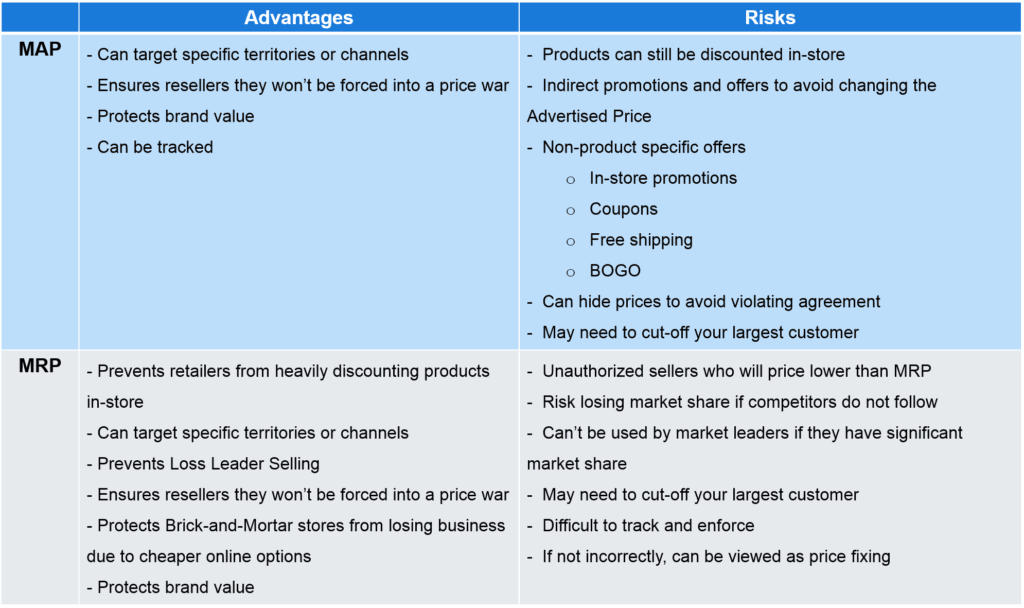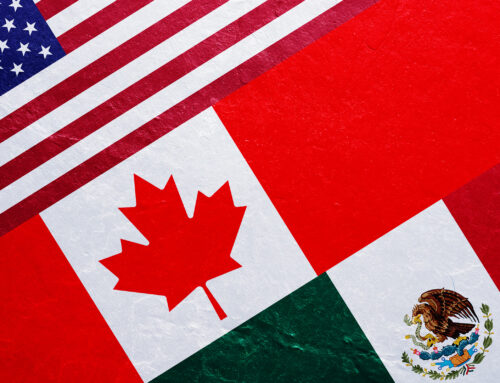With more consumers choosing to shop online over brick-and-mortar stores, today’s pricing strategies need to manage online distribution channels. Recently online resellers, with minimal overhead and few expenses, have been driving volume to their online stores through aggressive price discounts on flag ship or value items. This practice has resulted in lower average retail prices and has decreased in-store purchases. However, with Minimum Advertised Price (MAP) and Minimum Resale Price (MRP) agreements legally enforceable, in both Canada and the United States, manufacturers can now ensure that all online and brick-and-mortar stores maintain an agreed upon minimum price, ensuring fair competition across all channels and giving you more control of your products price.
What is Minimum Advertised Price (MAP)
MAP pricing policies state the minimum price a reseller can advertise a product for and sets rewards and punishments for compliance to these policies. Agreeing to a MAP doesn’t necessarily imply that a retailer can’t sell the product for less than the agreed price, it simply states that they cannot advertise the product, outside of the four walls of their store, for a price less than the agreed upon amount.
Apple and GoPro are examples of two companies with strict MAP policies. Apple uses MAP with their resellers in two ways. First, they enforce strict signed MAP agreements with their resellers, which dictate the minimum advertised price points. Second, Apple offers lower margins to their channel distributors to prevent resellers from pricing their products below the agreed upon MAP. GoPro, much like Apple, monitors their inventory levels and keeps a close eye on their retail partners to ensure that their products are being advertised at, or above, their MAP. Both Apple and GoPro have explicitly stated they will terminate any contract with resellers who promote their products below MAP.
But You Should Know…
Unfortunately, even when a MAP is signed, retailers are able to get around the minimum advertised price. Remember, MAP states the price a product must be advertised for, not necessarily sold for. Resellers get around their MAP agreements by using e-store wide offers, coupons, Buy-One Get-One Free promotions, and other such in-store deals. The retailer is therefore not in violation of their MAP agreements as they are not changing the advertised sales price, they are changing the total basket price. Another way resellers are getting around their MAP agreements, is by hiding online product prices. For example sites like Amazon and Alibaba, will hide the price until the item is placed in the Shopping Cart, or will only display the price ‘upon request’. Retailers will state on print or online advertisements to check in-store details for pricing – as they can reduce the price of their items in their stores. …
What is Minimum Resale Price (MRP)
Another policy that you can legally enforce is a Minimum Resale Price (MRP). Minimum Resale Price is a price maintenance policy manufacturers put in place to ensure that resellers are selling a product at, or above their desired minimum price point, at the checkout. In Canada and the US, suppliers can refuse to sell to and can discriminate against a reseller if they do not adhere to their MRP. Manufacturers argue that a MRP can be used to prevent ‘loss leader selling’ and has many of the same benefits as MAP; specifically protecting a products’ value from being tarnished by discounting and ensuring brick-and-mortar retailers make enough margin to provide proper training for customer service.
In 2012, two of the world’s largest TV makers, Sony and Samsung, started enforcing MRP’s on their TV sets, in order to help brick-and-mortar retailers improve margins, which had fallen by 15%. In an effort to stop this slide, the two consumer electronic giants begun enforcing minimum resale prices. Although Sony had previously set strict MRP’s for PlayStation products and camcorders, the effort to enforce minimum resale prices on HDTV’s, was new to the category. Enforcing MRP on a category, which traditionally did not enforce these agreements, proved to be risky. If all manufacturers do not follow, you could lose valuable market share to competitors, continuing to see their sales grow through discounts on online channels such as Amazon.
In order for resellers and distributors to comply with MAP and MRP policies, manufacturers will typically give something in return for abiding by the policies. The return may be in the form of co-op advertising dollars, exclusivity on specific areas or territories, better wholesale prices, or preferred treatment on new products.
Implementation/Enforcement paragraph
Prior to 2009 in Canada, and 2007 in the United States, implementing price maintenance policies such as MAP or MRP was considered anti-competitive and illegal. However, with amendments to the Competitions Act in Canada, and Anti-Trust Laws in certain States*, a manufacturer may use an agreement or specified unilateral actions (threats or punishments), to enforce their MAP and MRP policies. In order for these policies to be enforceable, they must not be deemed to have any adverse effects on the market, must not have been influenced by a third party (IE a long-time distributor), and must be issued vertically and unilaterally, without exception. In Canada, issues may arise when a manufacturer with substantial market power** uses a MRP or MAP to their advantage. In this case, a complaint can be formally made to the Competition Bureau, at which point the Competition Tribunal will evaluate the situation. While fines and punishment cannot be issued by the Competition Tribunal, they may null their current, and prevent the manufacturer from using future price maintenance policies.
Enforcement of MAP and MRP policies has been an issue for manufacturers. By enforcing these agreements, manufacturers may be forced to cut off business with key retailers. However, to protect themselves, manufacturers may include in their policies a statement where they express that they are solely responsible for determining whether a company has violated the policy, and if so, determining an appropriate punishment. Appropriate punishment may come in the form of a warning, and the manufacturer reserves the right to cancel any pending orders, restrict future orders, or suspend a distributor account if they believe that the dealer has violated the policy.
Unauthorized Resellers
With so many online resellers to keep track of, manufacturers now also face a serious threat from unauthorized retailers. These unauthorized resellers purchase authentic products and, as they are not bound by a MRP or MAP agreement, sell them on websites such as eBay and Amazon, below the agreed upon prices. While manufacturers are able to track and report unauthorized resellers, they largely must do so on their own; and while many have pleaded with Amazon to find and punish these unauthorized resellers, Amazon takes a percentage of third party sales through their website, and as such, are hesitant to enforce seller pricing agreements. This has caused major issues for manufacturers, as unauthorized dealers vulture sales, and deplete product perceived value, by selling and advertising it at a lower cost.
William Levins, a blogger on Nuvonium, suggests that there are two ways for manufacturers to prevent unauthorized resellers from selling their products on Amazon or eBay. Firstly, limit or monitor sales and promotional offers. If you offer deals such as discounts and BOGO promotions, and you find a customer has purchased an unusually large quantity of one item, it’s likely that they are unauthorized retailer intending to resell those products at a discounted price (or perhaps they really just want 10,000 “Tickle Me Elmo” dolls). Secondly, if possible, custom code products sold to resellers, to police products sold at steep discounts. If you find that the products codes found on Amazon, eBay, etc. are all from a single reseller, they likely are running a concealed retail site, under a different name, and are violating your reseller agreement.

Conclusion
Price maintenance policies such as MAP and MRP can be valuable tools to protect your brand and ensure adherence to your pricing strategy. However, you should not implement MAP or MRP policies if you are not prepared to enforce it upon all resellers. Losing key business is a risk a company must take when implementing price maintenance policies, as they must be enforced vertically and unilaterally for them to be legal. MAP is beneficial to both manufacturers and distributors, as it ensures retailers that they will not lose business from retailers promoting a lower price online. Minimum Resale Price, takes the MAP a step further, requiring all authorized retailers to sell their product at, or above the agreed upon price, at the risk of losing supply from the manufacturer. Using MAP and MRP agreements can promote fair competition, protect seller margins, ensure proper training at the customer service level, and finally, protect your brand value from being diminished by loss-leaders and unauthorized retailers.
* Several states including New York, Illinois, Michigan, Maryland, and California still regard MRP as illegal under their states Anti-Trust Laws
**Greater than 35% market share
Additional Reading:
- http://insight.kellogg.northwestern.edu/article/when-retail-prices-cross-the-line
- http://www.wsj.com/articles/SB122835660256478297
- https://www.amazon.com/forum/where%20is%20the%20price?cdForum=FxGDJ62NQQH2Y8&cdThread=Tx2JDZTEHKGYBXU
- http://www.americanbar.org/publications/franchise_lawyer/2013/fall_2013/roadmap_to_minimum_advertise_price_policies.html
- http://www.kellogg.northwestern.edu/faculty/anderson_e/htm/personalpage_files/Papers/Determinants_of_MAP_Violations.pdf
- https://www.ftc.gov/tips-advice/competition-guidance/guide-antitrust-laws/dealings-supply-chain/manufacturer-imposed
You may be interested in this Case Study:






